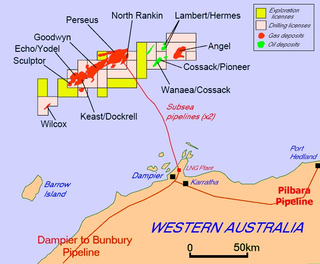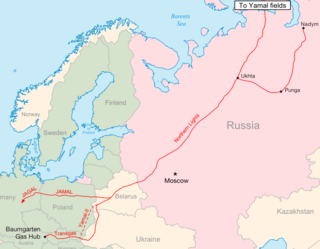
PJSC Gazprom is a Russian majority state-owned multinational energy corporation headquartered in the Lakhta Center in Saint Petersburg. As of 2019, with sales over $120 billion, it was, until 2023, ranked as the largest publicly listed natural gas company in the world and the largest company in Russia by revenue. In the 2020 Forbes Global 2000, Gazprom was ranked as the 32nd largest public company in the world. The Gazprom name is a contraction of the Russian words gazovaya promyshlennost. In January 2022, Gazprom displaced Sberbank from the first place in the list of the largest companies in Russia by market capitalization. In 2022, the company's revenue amounted to 8 trillion rubles. In 2023, the company is delisted from international markets, and continues substantial constriction in its operational results.
The Shtokman field, one of the world's largest natural gas fields, lies in the northwestern part of the South Barents Basin in the Russian sector of the Barents Sea, 600 kilometres (370 mi) north of Kola Peninsula. Its reserves are estimated at 3.8 trillion cubic metres of natural gas and more than 37 million tons of gas condensate.
The Urengoy gas field in the northern West Siberia Basin is the world's second largest natural gas field after South Pars / North Dome Gas-Condensate field. It lies in the Yamalo-Nenets Autonomous Okrug, Tyumen Oblast, Russia, just south of the Arctic circle. It is named after the settlement of Urengoy. The gas field is operated by Gazprom Dobycha Urengoy and serviced by the town of Novy Urengoy, founded in 1973.
The Sakhalin-2 project is an oil and gas development in Sakhalin Island, Russia. It includes development of the Piltun-Astokhskoye oil field and the Lunskoye natural gas field offshore Sakhalin Island in the Okhotsk Sea, and associated infrastructure onshore. The project is managed and operated by Sakhalin Energy Investment Company Ltd..

The Yamal Peninsula is located in the Yamalo-Nenets Autonomous Okrug of northwest Siberia, Russia. It extends roughly 700 km (435 mi) and is bordered principally by the Kara Sea, Baydaratskaya Bay on the west, and by the Gulf of Ob on the east. At the northern end of this peninsula lie the Malygina Strait and, beyond it, Bely Island. Across the river lies the Gyda Peninsula. In the language of its indigenous inhabitants, the Nenets, "Yamal" means "End of the Land".
ARETI International Group of Companies is a private energy company headquartered in Geneva, Switzerland. ARETI was created by Igor Makarov in 2015 following his sale of Itera International Group of Companies, which was started in 1992 and sold off in 2013. The ARETI group company consists of holding companies registered in Cyprus, Virgin Islands, and the Netherlands and has subsidiaries involved in the energy industry, civil and industrial engineering, and finance. The company operates primarily in Switzerland and the Commonwealth of Independent States (CIS) countries. In 2013, its main subsidiary, Itera Oil & Gas Company, was acquired by Rosneft prior to any sanctions placed on Rosneft.

Novatek is Russia's second-largest natural gas producer, and the seventh-largest publicly traded company globally by natural gas production volume. The company was originally known as OAO FIK Novafininvest. Novatek is based in the Yamalo-Nenets Autonomous Region in West Siberia, and maintains a head office in Moscow. In the 2020 Forbes Global 2000, Novatek was ranked as the 316th-largest public company in the world.

The Yamal–Europe natural gas pipeline is a 4,107-kilometre-long (2,552 mi) pipeline connecting Russian natural gas fields in the Yamal Peninsula and Western Siberia with Poland and Germany, through Belarus. The Poland portion ceased operating in 2022.

The Yuzhno-Russkoye field is a Russian oil and gas field located in the Krasnoselkupsky District, Yamal-Nenets Autonomous Okrug, Tyumen Oblast.
The Power of Siberia 2 is a proposed natural gas pipeline to export natural gas from Russia's Western Siberia Altai region to North-Eastern China.
The Kovykta gas condensate field is one of the largest undeveloped natural gas fields in Eastern Siberia, Russia. The field is located in the northern part of the Irkutsk Oblast, in the Zhigalovo and Kazachinsko-Lensk districts.

The North West Shelf Venture, situated in the north-west of Western Australia, is Australia's largest resource development project. It involves the extraction of petroleum at offshore production platforms, onshore processing and export of liquefied natural gas, and production of natural gas for industrial, commercial and domestic use within the state.

The Sakhalin–Khabarovsk–Vladivostok pipeline is a pipeline for natural gas in Russia, transporting Sakhalin's gas to the most populated and industrialized regions of the Russian Far East. It is also projected to become a part of an international export route, carrying Russian gas to East Asian countries, such as the People's Republic of China, South Korea and Japan. The pipeline is owned and operated by Gazprom. It was opened on 8 September 2011.

Power of Siberia is a Gazprom-operated pipeline in Eastern Siberia that transports natural gas from Yakutia to Primorsky Krai and China. It is a part of the eastern gas route from Siberia to China. The proposed western gas route to China is known as Power of Siberia 2.

Northern Lights is a natural gas pipeline system in Russia and Belarus. It is one of the main pipelines supplying north-western Russia and is an important transit route for Russian gas to Europe.
Chayanda field is a large hydrocarbon resource field, primarily of natural gas and gas condensates. It is located in the Lensky District of the Sakha Republic in Yakutiya.
The Bovanenkovo gas field is a natural gas field located in the Yamalo-Nenets Autonomous Okrug. It was discovered in 1972 and developed by Gazprom. It began production in 2012 and produces natural gas and condensates. The total proven reserves of the Bovanenkovo gas field are around 171.5 trillion cubic feet (4.9×1012 cubic metres), and production is stated to be around 11 billion cubic feet (311,000,000 cubic metres) per day in 2010. The Bovanenkovo gas field is part of the Yamal project.
Yamal LNG is a joint venture based around a liquefied natural gas plant located in Sabetta at the north-east of the Yamal Peninsula, northwest Siberia, Russia. In addition to the LNG plant, the project includes production at the Yuzhno-Tambeyskoye gas field, and the transport infrastructure, including the Sabetta seaport and airport.
The Kharasavey gas field is a natural gas field located in the Yamal Peninsula. It was discovered in 1966. Gazprom intends to start production in 2023, requiring a new pipeline to join the Yamal–Europe pipeline.

The Northern Latitudinal Railway is a Russian railway line previously under construction in the Yamalo-Nenets Autonomous District. It is 707 kilometres long, along the Obskaya - Salekhard - Nadym - Novy Urengoy - Korotchaevo route, which should link the western and eastern parts of the autonomous region, linking the Northern Railway in the east with Sverdlovsk Oblast. The project is run jointly by the Government of Russia, the governments of the Yamal-Nenets Autonomous District, PJSC Gazprom, JSC Russian Railways, and Development Corporation JSC. The construction coordinator of the railway is the Federal Agency for Railway Transport (Roszheldor). Construction of the NLR is planned to be carried out from 2018 to 2022. The estimated volume of traffic at completion is 24 million tons. Initially, the highway was supposed to be laid by 2015, but due to the lack of a budget solution, the project completion dates were repeatedly postponed. In February 2017, the construction was announced to be completed in 2023. The project cost was estimated at 239 billion Rubles. In November 2022, it was announced that the government had suspended this project in favor of expanding rail eastward.











